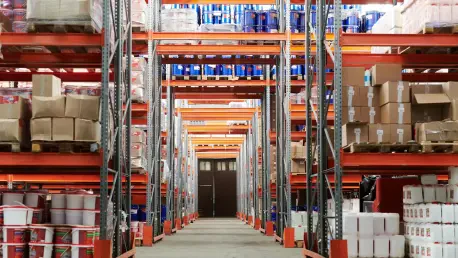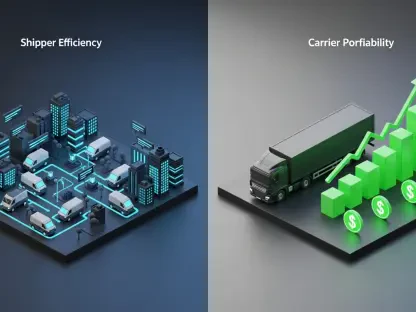In the fast-paced world of retail logistics, where efficiency and sustainability are paramount, the challenge of managing rising costs for labor, fuel, and single-use packaging looms large, putting immense pressure on retailers. They are grappling with the dual demands of maintaining profitability while meeting stringent environmental targets. Enter the Dolly Max Packaging System by Loadhog, a modular rolling container solution that promises to revolutionize returnable transit packaging (RTP). This technology review dives deep into how this innovative system addresses these pressing issues, offering a glimpse into a tool that could redefine operational norms in the retail sector.
Key Innovations in Returnable Transit Packaging
Returnable transit packaging has emerged as a critical strategy for retailers aiming to cut costs and reduce environmental impact. Unlike traditional methods such as roll cages or shrink-wrapped pallets, RTP focuses on reusability, allowing companies to minimize waste and streamline logistics. The concept prioritizes durable, recyclable materials over disposable packaging, aligning with global sustainability goals.
The Dolly Max system stands out in this landscape as a cutting-edge solution designed to tackle inefficiencies head-on. Developed by Loadhog, it offers a flexible, modular approach that caters to the diverse needs of modern retail supply chains. Its relevance is underscored by the growing demand for systems that not only save money but also contribute to a greener footprint in logistics operations.
This review will explore the standout features of the Dolly Max, assess its real-world performance, and evaluate its potential to shape the future of retail logistics. By examining its design, efficiency gains, and sustainability benefits, a comprehensive picture of its impact will emerge.
Breaking Down the Dolly Max Features
Modular Versatility for Diverse Needs
One of the defining aspects of the Dolly Max system is its modular design, which allows retailers to customize container configurations for a wide range of products. Whether handling bulk goods or irregularly shaped items like cushions or sports equipment, the system adapts seamlessly. This flexibility eliminates the need for multiple packaging solutions, simplifying inventory management.
Compatibility with Loadhog containers and the reusable Pallet Lid further enhances its utility. By replacing single-use packaging, the system reduces waste and boosts operational adaptability. Retailers can mix and match components to suit specific requirements, ensuring a tailored approach to logistics challenges.
This adaptability is not just a theoretical advantage but a practical one, as it supports varied supply chain demands without compromising efficiency. The ability to handle diverse goods within a unified framework positions the Dolly Max as a versatile tool for modern retail environments.
Ergonomic Efficiency for Labor Savings
Beyond its modular design, the Dolly Max prioritizes ergonomic features that significantly reduce labor demands. Equipped with a one-touch brake mechanism, the system ensures easy handling and maneuverability, even in busy warehouse settings. Such design elements minimize physical strain on workers, improving safety and productivity.
Real-world applications highlight these benefits, with retailers like Harvey Nichols reporting substantial reductions in handling touchpoints. By eliminating up to four manual interactions in their supply chain, the system has delivered measurable labor cost savings. This efficiency is crucial in an industry where workforce expenses continue to rise.
The focus on ergonomics also translates to faster processing times, as staff can move goods with less effort. This reduction in operational friction underscores the Dolly Max’s role as a labor-optimizing solution, addressing one of the most persistent challenges in logistics.
Transport Optimization and Security Measures
Transport efficiency is another area where the Dolly Max excels, offering a 20% higher vehicle fill rate compared to traditional roll cages. This increased capacity allows for better utilization of delivery vehicles, including smaller ones, which can lead to reduced fuel consumption and lower transport costs. Such optimization is vital for retailers aiming to streamline distribution networks.
Asset security is equally prioritized through integrated labeling and tracking options. These features enhance supply chain visibility, ensuring that goods and equipment are accounted for at every stage. The ability to monitor assets in real time mitigates risks of loss or theft, a common concern in large-scale logistics operations.
Together, these transport and security enhancements make the Dolly Max a robust solution for improving logistical workflows. The combination of higher fill rates and better tracking capabilities offers a compelling case for its adoption in high-volume retail environments.
Sustainability at the Core of Design
Sustainability remains a driving force in retail logistics, with increasing emphasis on reducing waste and carbon emissions. The adoption of RTP systems aligns directly with these goals, offering a path to minimize environmental impact. Retailers are under growing pressure to meet regulatory standards and consumer expectations for eco-friendly practices.
The Dolly Max contributes to this trend by incorporating recycled materials in its construction, helping companies avoid plastic taxes in regions like the UK. Additionally, Loadhog’s swap-out program ensures full recyclability at the end of the system’s lifecycle, closing the loop on waste. This commitment to sustainable materials sets a high standard for the industry.
By reducing reliance on single-use packaging, the system also cuts down on landfill contributions, aligning with broader circular economy principles. Such features make the Dolly Max not just a logistical tool but a strategic asset for retailers pursuing long-term environmental responsibility.
Real-World Performance and Adaptability
Practical deployments of the Dolly Max reveal its transformative potential in retail settings. For instance, Harvey Nichols has leveraged the system to streamline operations, wheeling containers directly onto shop floors for faster restocking. This direct approach eliminates intermediate handling steps, saving time and reducing clutter in retail spaces.
In distribution centers, the ability to link multiple dollies for rapid marshalling has proven invaluable. This feature accelerates the movement of goods during peak demand periods, ensuring scalability in fluctuating supply chains. The system’s design supports dynamic operational needs without requiring extensive retraining or infrastructure changes.
These use cases demonstrate how the Dolly Max adapts to varied retail environments, from high-end stores to sprawling warehouses. Its ability to address specific pain points, like waste reduction and operational speed, highlights its real-world value as a comprehensive logistics solution.
Challenges in Adopting RTP Technology
Despite its advantages, transitioning to RTP systems like the Dolly Max is not without hurdles. The initial investment required for implementation can be a barrier, particularly for smaller retailers with tight budgets. This upfront cost often deters adoption, even when long-term savings are evident.
Resistance to change also plays a role, as many companies are accustomed to traditional packaging methods. Overcoming this inertia requires targeted education on the economic and environmental benefits of RTP. Loadhog and partnering retailers are actively working to address these concerns through case studies and pilot programs.
Integration into existing logistics frameworks poses another challenge, as supply chains often rely on entrenched systems. However, ongoing efforts to demonstrate compatibility and provide tailored support are helping to ease this transition, paving the way for broader acceptance of innovative solutions like the Dolly Max.
Looking Ahead: The Evolution of RTP Systems
As retail logistics continues to evolve, the future of RTP and the Dolly Max system appears promising. Potential advancements in design, such as lighter materials or enhanced automation compatibility, could further boost efficiency. Innovations in tracking technology might also improve asset management over the coming years, from 2025 onward.
The long-term impact of RTP on the retail sector lies in its ability to balance economic pressures with environmental stewardship. As more companies recognize the strategic value of sustainable packaging, adoption rates are expected to rise. Systems like the Dolly Max could become industry standards, reshaping how goods are moved and stored.
Speculation on broader trends suggests that collaboration between technology providers and retailers will drive further refinements. This partnership approach will likely yield solutions that are even more tailored to specific industry needs, ensuring that RTP remains a cornerstone of modern logistics strategies.
Final Verdict and Next Steps
Looking back, the review of the Dolly Max Packaging System revealed a tool that successfully addressed key challenges in retail logistics with its modular design, ergonomic efficiency, and sustainability focus. Its performance in real-world scenarios, such as with Harvey Nichols, proved its capacity to streamline operations and reduce environmental impact.
For retailers considering adoption, the next step involves conducting pilot programs to test the system within their unique supply chains. Partnering with Loadhog to customize configurations and training staff on new workflows emerges as a critical action to ensure smooth integration.
Beyond individual adoption, the industry as a whole stands to benefit from shared learning and collaborative innovation. Exploring funding options or incentives for sustainable packaging initiatives could accelerate the shift to RTP, ensuring that tools like the Dolly Max play a central role in building a more efficient and eco-conscious retail future.









